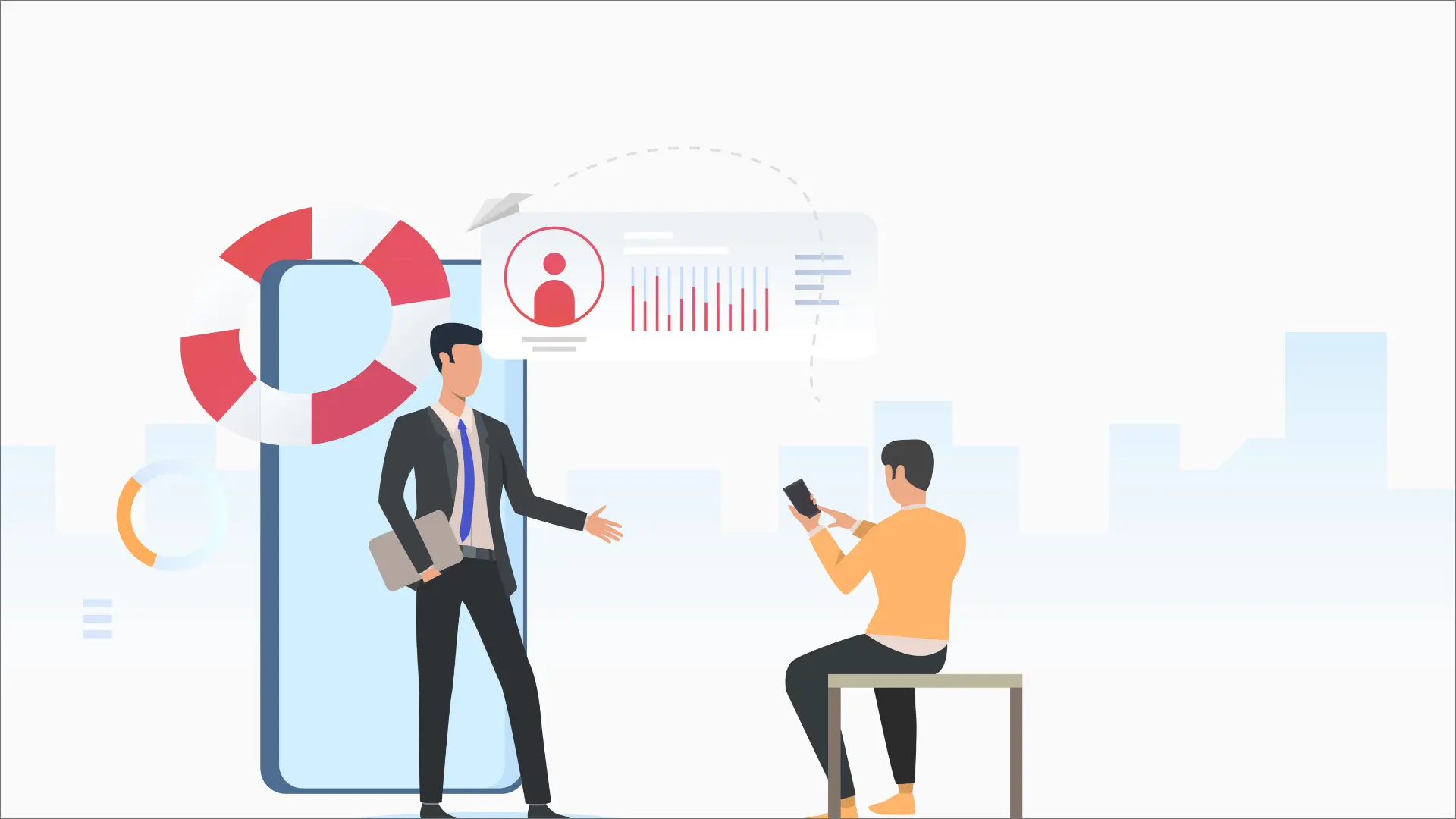In today’s fast-evolving business landscape, it has become crucial for businesses to deliver exceptional customer service and stand out from their competitors. Technological advancement has transformed traditional call centers into dynamic contact centers with a wide range of communication channels.
Blended contact centers are among the latest advancements in this field. It is transforming the customer support sector by incorporating incoming and outgoing calls via the same call center. Now you may think that phones are also supposed to simultaneously support both types of calls.
Although it may be true for handheld devices, it is not the same with contact centers. They must be well-equipped to handle large volumes of calls simultaneously. That is why they need intelligent routing software to manage calls and improve customer interactions.
This guide will describe everything you need to know about a blended call center.
What Is A Blended Call Centre?
A blended call center is a powerful approach that integrates digital channels, voice, and self-service options to revolutionize customer engagement. Such contact centers are equipped with software to handle incoming and outgoing calls and are operated by professionally trained agents. Depending On the type of business, the agents of contact centers can be compassionate customer support executives or keen salespersons.
With a blended call center, your agents are not limited to only inbound or outbound calls and can do both. Unlike inbound contact centers, agents do not have to wait for customers to reach out, but they can proactively approach customers, which results in increased customer satisfaction.
Advanced call center software like VoIP has automatic call distribution features to manage many customers and intuitive calling features so that agents can contact prospects at various stages of their lifecycle.
What Are The Benefits Of Blended Call Centers?

If you have a well-equipped call center, it will help you increase your agents’ customer satisfaction and efficiency. There are many other benefits of having a blended call center which is as follows:
1. Increased Productivity And Efficiency
Blended call center allows call center agents to switch between inbound and outbound calls and efficiently route calls to qualified agents when needed. It significantly helps optimize agents’ time and ultimately increases the efficiency of your call center.
In a blended call center environment, the system automatically redirects the customer to the next available agent when an agent cannot take a call. This efficient approach reduces the customer’s waiting time and allows more calls to be handled by agents, resulting in improved productivity.
2. Enhanced Customer Satisfaction
The blended call center solution offers unrestricted agent access to customers with the help of advanced features such as custom scripting and two-way communication chat capabilities.
Constant availability, quick resolution of customers’ complaints, and instant answering of customers’ queries can inevitably improve customer satisfaction. In addition, blended contact centers also play a role in reducing wait times which also helps in improving customer satisfaction.
3. Increased Revenue
Another significant benefit of blended contact centers is that it opens new avenues of upselling and cross-selling, which results in increased sales. When customers can interact with the same agents in both inbound and outbound calls within a blended contact center, they tend to be more receptive to the recommendations provided by those agents. This continuity of interaction builds trust and credibility, making customers more inclined to listen and consider the suggestions given by the agents.
Furthermore, blended contact centers integrate multiple communication channels, like live chat software, alongside voice calls. This integration offers several benefits, including substantially reducing operating costs, overhead expenses, and the need for overtime. By leveraging these cost-saving measures, businesses can effectively increase their revenue while maintaining excellent customer service standards.
4. Real-Time Monitoring
Blended call center software also allows agents to monitor calls in real-time so that they have access to important information at the right time. It not only improves customer satisfaction but also helps in making it better.
By combining real-time data with historical data, you gain valuable insights into immediate issues, allowing you to address them promptly. This powerful combination enables you to identify and understand ongoing challenges in real time, empowering you to take swift action and resolve them on the spot.
This proactive approach helps ensure that you can effectively tackle emerging issues as they occur, leading to more efficient problem-solving and improved overall performance.
What Are The Essential Features Of Blended Call Centers?
The robust features of a blended call center lead to the compelling list of benefits described above.
The following are the essential features of a blended contact center:
i. Power Dialer
Adding a line after the above text: You can also use power dialer CRM, to track call outcomes, manage customer interactions, and streamline your sales process for enhanced productivity.
ii. Call Queuing
You can improve customer experience with the help of call queuing features by placing incoming calls in the call queue when agents are busy attending to other calls.
iii. Smart Call Forwarding
This feature helps you forward calls to other devices or locations to ensure availability and improve customer experience.
IV. Call Recording
With the help of a call recording feature, you can listen to calls at any time to monitor agents’ performance and identify common problems that customers are facing.
V. Call Barging And Whispering
You can join the conference bridge as a supervisor and actively listen to customer queries. It empowers you to provide prompt solutions to agents, enabling them to address and resolve customer issues swiftly.
Vi. Call Conferencing
With the help of a call conferencing feature, you can add a third person to your two-way call.
Vii. Call Monitoring
It is a robust feature of blended call centers that helps supervisors and managers silently monitor calls in real time and improve agents’ performance.
Viii. Call Transfer
This feature helps to redirect a connected call to other agents when you are busy.
ix. Call Centre Analytics
Harness the power of data to drive team efficiency and enhance the customer experience. Making informed decisions is the cornerstone of success in your business.
Explore the world of call center analytics to gain valuable insights and ensure that every decision you make is geared towards profitability and growth.
How Can You Set up A Blended Call Centre
Now that you understand what a blended call center is and how it can benefit your business let’s look at some steps that help you set up a blended contact center.
Step 1: Set Up the Agent's Access
It is the most important step for all the inbound calls in your contact center. You must decide whether your customers can contact your agents directly or use Interactive Voice Response (IVR). An IVR is a virtual assistant that sends automated greetings to customers and offers menu options. You can also set up a multi-level IVR for your call center.
Some IVRs only handle general inquiries, troubleshoot common problems, generate or cancel tickets, and book reservations. In addition to providing pre-recorded solutions, the IVR system can intelligently redirect calls to live agents if customers express dissatisfaction or need further assistance.
Furthermore, it is important to set up call routing for after-hours calls, directing them to a dedicated team of agents or voicemail for appropriate handling and timely responses.
Step 2: Create Agent IDs
The next step is creating a database for your blended call center agents. You can simply use their names to save their profile or assign nicknames, and also you have to make email IDs and agent IDs.
If you are already using CRM software, you have the upper hand to use CRM IDs as agent IDs of your employees. Good CRM software and a cloud-based communication system can help you improve the productivity and efficiency of your contact center.
Step 3: Group Agents Based On Their Skills
As a blended call center, you may have to deal with different types of calls with different requirements. So you need to create different skill groups to tackle different sales queries and problems.
The number of groups and agents in a group depends on the number of employees you have. This skill-based grouping is more efficient for your brand.
Step 4: Optimize Automated Call Distribution (ACD)
Cloud-based contact centers utilize powerful Automated Call Distribution (ACD) systems to manage inbound traffic efficiently, reducing wait times and enhancing the overall customer experience. Integration with CRM software enables identifying high-priority customers and prioritizing their needs for exceptional support.
Moreover, ACD software also offers a sticky agent feature, assigning the same agent to callers for improved satisfaction. Marketers are increasingly prioritizing personalized experiences in customer service, as indicated by a recent report from GetFeedback.
Step 5: Define the Data Format
In a blended call center, you will deal with inbound and outbound calls, so it is essential to define a data format for your dialer. This way, when the dialer understands your outbound calling strategy, it will automatically find the number from the database and dial calls. It ultimately eliminates human error and reduces dialing time.
Step 6: Collecting Feedback
You must establish a customer feedback response sheet that will help you improve your agent performance and the productivity of your call center. You can send a link to your customer’s phone numbers to get their feedback.
What Are The Challenges In Running A Blended Call Centre Software?
Although call centers are very effective for improving your customer service, they have certain challenges you must consider.
1. Technical Challenges
Like any technology-focused department, blended contact centers experience ongoing technical challenges. During peak periods, phone lines may become congested, and even Automated Call Distribution (ACD) systems can struggle to optimize call queues. These technical issues can potentially reduce productivity and lead to customer frustration.
2. High Attrition Rates
The contact center industry is characterized by long working hours and a demanding environment, often accompanied by challenging performance targets.
That is why it faces a significant issue with high attrition rates. Blended agents frequently depart without fulfilling their notice period or providing prior notice.
3. Financial Constraints
A high agent turnover rate necessitates continuous investment in recruiting and training new resources, leading to substantial long-term costs for the company. Some companies avoid establishing a blended call center to mitigate this financial burden.
4. Poor Customer Services
As businesses expand, the support department faces many complex customer issues. Resolving these concerns may require additional time, leading to declining customer satisfaction.
Research indicates that 44% of customers become frustrated when placed on hold for 5-15 minutes.
Some Best Practices To Implement In A Blended Call Center
Here we describe some features you can implement in your blended call center to maximize efficiency and productivity.
- Training Of Employees
To address high attrition rates, providing thorough training to agents on blended call center services and solutions is crucial. Speed up the onboarding process for new employees to mitigate the impact of attrition.
It is an opportune time to identify agents’ weaknesses and provide them with resources to overcome challenges. Foster a coaching culture among agents to promote continuous learning and mutual support.
- Use Intuitive Call Center Solution Tools
Blended call center software offers advanced capabilities compared to unidirectional call applications. These software solutions provide access to niche features and tools that improve customer experience.
For instance, some contact center software includes a call whispering tool, enabling managers to join calls to guide agents and take over when necessary.
- Monitor Software Metrics
Monitoring the performance of blended call center services is essential, just like any other business department. Continuously tracking key performance indicators (KPIs) and return on investment (ROI) ensures that complacency is avoided and allows for ongoing service improvements. Key metrics to focus on include average handle time, call abandonment, agent scheduling, voice call resolutions, and average hold time.
Can VoIP Help In Setting Up A Blended Call Center?
Flexible Call Handling
Scalability
Cost-Effective Communication
Unified Communication Features
CRM Integration
Remote Work Support
Real-Time Monitoring and Analytics
Conclusion - Cold Calling
Blended call centers are transforming the customer support sector by integrating inbound and outbound calls and various communication channels. They offer numerous benefits, including increased productivity and efficiency, enhanced customer satisfaction, increased revenue through upselling and cross-selling, and real-time monitoring capabilities.
Essential features such as power dialers, call queuing, smart call forwarding, call recording, and call monitoring contribute to their success. However, running a blended call center also comes with technical issues, high attrition rates, financial constraints, and the need to address complex customer concerns.
By implementing best practices such as comprehensive training, using intuitive call center solutions, and monitoring software metrics, businesses can maximize the efficiency and productivity of their blended call centers.




